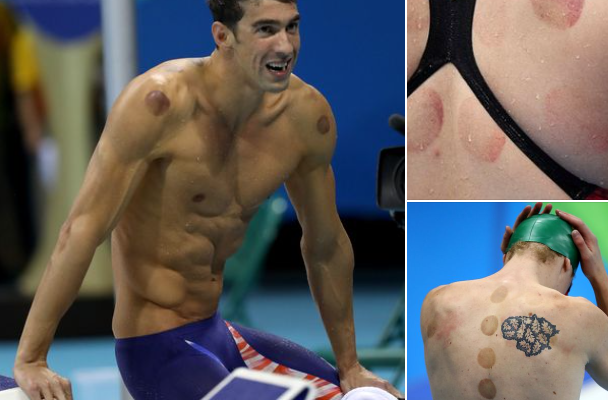Here’s why Olympic athletes and celebrities have dark red circles on their bodies

If you watched any of the Olympics, you probably noticed that several athletes looked like they’d been slapped by an octopus.
The medal-shaped body art seen on their bodies weren’t caused by the suckers of an octopus, nor are they magical markings of a winner.
The perfectly rounded marks, often seen on the shoulders and back, is an ancient technique that can help performance.
When Michael Phelps won his first gold medal at the 2016 Rio Olympics, his win was temporarily eclipsed by the large purple dots on his back and across his shoulders.
The online community was buzzing with netizens attempting to guess the cause of the perfectly shaped circles on the Olympian’s body.
“There are crop circles on Michael Phelps’ back??” asks one user who was puzzled by the marks.

“Got in a fight with the vacuum at the carwash again…” tweets a second user.
A third shares, “Michael Phelps probably just fell asleep on his medals.”
Trending procedure
Rio’s bronze medalist Alexander Naddour, a retired American artistic gymnast, and Belarusian swimmer Pavel Sankovich also appeared on the podium with those peculiar spots.
In the 2024 Paris Olympics, US endurance swimmer Katie Ledecky won bronze, and Italy’s Nicolò Martinenghi accepted a gold medal for the men’s 100 breaststroke. Both had the mysterious marks on their body.
Though it seems there’s a correlation between success and athletes bearing the marks, it is not magical ink that ensures a win.
In fact, it’s an ancient therapy, called cupping, that’s been trending among elite athletes and celebrities, in part due to the legendary Phelps.
Cupping
In the ancient form of the therapy, believed to originate in Egypt or China, the air inside a cup is heated before being placed on trigger points, creating suction in that cupped area, causing a bruise.
Some people say they do experience a release in muscle tension afterwards, but there’s not much research to prove one way or the other.
There are different methods of cupping, including:
- Dry Cupping: This involves creating suction in the cups and placing them on the skin without making any incisions. The suction draws blood to the surface of the skin and is thought to help with muscle tension, pain, and inflammation.
- Wet Cupping: This method involves making small incisions on the skin before applying the cups. The suction then draws out a small amount of blood. It is believed to help with detoxification and to improve blood flow.
- Fire Cupping: This involves heating the inside of the cups with a flame before placing them on the skin. The heat creates a vacuum effect when the cups cool down.
- Air Cupping: This method uses a mechanical pump to create suction in the cups, eliminating the need for heat.
The modern form of the therapy, and the one used by several athletes and celebrities, uses cups attached to suction pumps. And the marks usually disappear within two weeks.
Provides relief
Former Olympian Naddour previously said that cupping provides relief from the soreness and pounding that come from gymnastics.
Speaking with USA Today in 2016, Naddour said, “That’s been the secret that I have had through this year that keeps me healthy. It’s been better than any money I’ve spent on anything else.”
Naddour, now a realtor in Arizona, adds, “Our bodies are going to hurt after doing this for so long. It’s the best thing that I’ve ever had…It has saved me from a lot of pain.”
And Sankovich shares and Instagram post where his legs are seen covered in suction cups: “This kinda Saturday morning. Cupping is a great recovery tool,” he writes.
Does it really work?
According to Mayo Clinic anesthesiologist Dr. Michael Joyner, “athletes are looking for any edge – real or imagined – they can get.”
The doctor, who studies elite athletes says there is no evidence that “shows cupping works or does not work,” which is also “true for a lot of mainstream ideas about warm-up and recovery. It is also true for a lot of outside-the-box ideas.” Explaining the thought process of athletes willingness to try anything new to relieve discomfort, he continues, “There can be placebo effects for these sorts of things, and what I tell athletes is that if they think it helps and there are no downsides, then, if it feels good, do it. The key is to not try anything brand new the day of competition.”
Cupping therapy is used for people suffering from all sorts of ailments including shingles, facial paralysis, vertigo, menstrual discomfort, cough and difficulty breathing and acne. But cupping is most commonly used to treat pain.
It is not only popular among athletes, celebrities like Justin Bieber, Kaley Cuoco, Jennifer Aniston, and Gwyneth Paltrow have also shown the same marks.
Have you had any experience with cupping? Please let us know what you think of this story and then share it with your friends so we can hear what others have to say!


